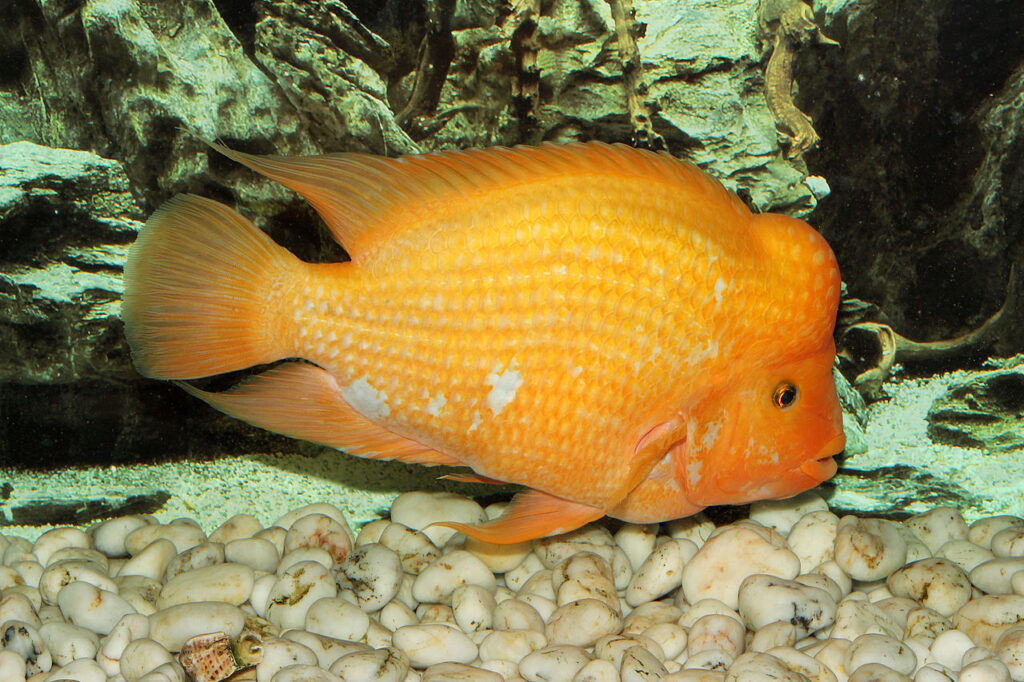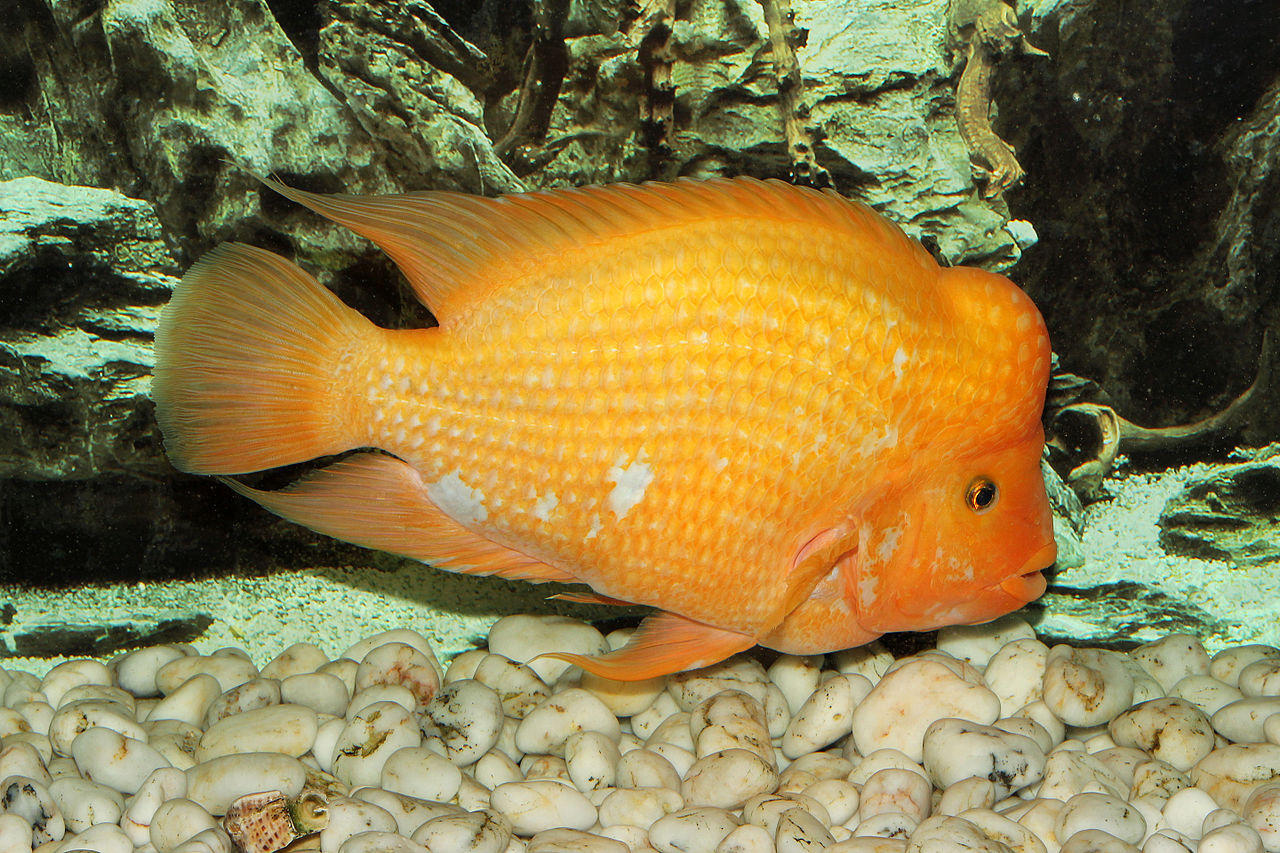Dive right into the interesting history of the Midas Cichlid. Originating from the freshwater ecosystems of Central America, this fascinating fish has been a staple in the aquarium trade since the late 20th century. Scientifically known as Amphilophus citrinellus, it belongs to the Cichlidae family, sharing relations with other popular cichlids like Oscars and Convict Cichlids.
Table of Contents
It’s not every day that you come across a Midas Cichlid. Though not extremely rare, they aren’t your run-of-the-mill aquarium fish either. They bring vibrant colors to your tank, ranging from white and yellow to fiery orange and red.
Now let’s talk variants. The most popular color morphs of this striking fish include yellow, white, and red. Each variant adds a unique aesthetic charm to your aquatic setup.
Navigating to its habitat and behavior, the Midas Cichlid is generally a mid-dweller but also enjoys exploring the bottom and top regions of the water column. Their diet is omnivorous, munching on everything from insects and small fish to plant matter. Though they add a lot of character to your tank, keep in mind that they are aggressive and territorial. They’re not the best choice for a peaceful community tank.
On the statistical front, these fish have an average size of 12-14 inches and can live up to 12 years. A tank size of at least 55 gallons is recommended to keep them happy and healthy.
Here’s a quick fact for you: Midas Cichlids are incredibly intelligent. They can even recognize their owners, adding a personal touch to your fish-keeping experience. Furthermore, their remarkable ability to change colors according to their mood or environment adds an element of surprise to your aquarium.
And for a little fun fact to wrap things up: some Midas Cichlids have been trained to perform simple tricks, and they often dig pits in the substrate to make nests. This makes them not just a pet but also an entertaining companion.

Key Information
The multitude of color morphs exhibited by the Midas Cichlid is truly captivating. These range from pristine whites and vibrant yellows to fiery oranges and deep reds. Each variant not only adds a unique aesthetic touch to your aquarium but also reflects the mood and behavior of the fish. This table below offers a comprehensive guide to various aspects of the Midas Cichlid, allowing you to understand what makes each variant special in its own right.
| Family | Cichlidae |
| Price | $20 – $50 depending on size and color |
| Common Names | Red Devil Cichlid, Dow’s Cichlid |
| Variants | White, Yellow, Orange, Red |
| Ideal Tank Size | Minimum of 55 gallons |
| Water Parameters | pH 6.5–8.5, Temperature 75–80°F, Hardness 6–25 dGH |
| Lifespan | Up to 12 years |
| Full Size | 12-14 inches |
| Natural Environment | Freshwater lakes and rivers in Central America |
| Behavior | Aggressive and territorial |
| Habitat Preference | Mid-water but will explore all levels |
| Aquarium Decoration | Rocky formations, driftwood, and live plants |
| Ideal Tank Mates | Other large and aggressive cichlids, some catfish species |
| Fish to Avoid | Small or less aggressive fish, shrimp |
| Best Foods/Diet | Omnivorous; insects, small fish, plant matter |
| Disease | Prone to Ich if water quality deteriorates |
| Sex-Switch | Capable of changing sex under certain conditions |
| Gender Differences | Males usually larger and more colorful |
| Care Level | Moderate |
| Breeding Level | Moderate to difficult; parental care is involved |
Ideal Tank Mates
When looking for suitable tank mates for the Midas Cichlid, it is crucial to carefully consider its aggressive and territorial nature. This means that your selection should ideally comprise larger, more robust fish that can hold their own against the Midas Cichlid. It’s also crucial to note that peaceful or small fish generally don’t make good companions, as they are likely to become targets. Therefore, the best tank mates usually belong to the same cichlid family or other families of larger, more aggressive fish. Here’s a detailed list of 15 fish that could make suitable tank mates for the Midas Cichlid.
Jack Dempsey Cichlid
The Jack Dempsey Cichlid is a robust, aggressive fish that can match the temperament of the Midas Cichlid. They are native to Central America and can grow up to 10 inches in length.
Oscar Fish
Another member of the cichlid family, Oscars are large and can grow up to 12 inches. They are known for their intelligence and interactive behavior, which can make them entertaining tank mates.
Convict Cichlid
Convict Cichlids are smaller than Midas Cichlids but are quite territorial and aggressive, which makes them able to hold their own in the tank.
Texas Cichlid
Native to North America, the Texas Cichlid is a large and aggressive species, making it a good match for the Midas Cichlid in terms of temperament.
Flowerhorn Cichlid
Known for their vivid colors and unique appearance, Flowerhorns are large and aggressive, which fits well with the Midas Cichlid’s behavior.
Green Terror Cichlid
The Green Terror is another cichlid species that is both large and territorial, making it capable of cohabiting with the Midas Cichlid.
Jaguar Cichlid
With striking patterns that resemble those of a jaguar, this fish is aggressive and prefers similar water conditions as the Midas Cichlid.
Plecostomus
Although not a cichlid, the Pleco is a hardy bottom-dweller that generally keeps to itself, making it less likely to provoke the Midas Cichlid.
Red Devil Cichlid
This fish is closely related to the Midas Cichlid and shares its aggressive and territorial nature, making them compatible tank mates.
African Cichlids
Specifically, the larger and more aggressive types of African Cichlids can be suitable tank mates due to their similar temperament.
Firemouth Cichlid
Another Central American native, the Firemouth Cichlid is smaller but can hold its ground against larger fish like the Midas Cichlid.
Bichir
These prehistoric-looking fish are bottom-dwellers and are generally left alone by Midas Cichlids due to their tough, armored bodies.
Giant Gourami
Growing up to 24 inches, the Giant Gourami is peaceful but its size makes it less likely to be bullied by the Midas Cichlid.
Clown Loach
Although not the ideal choice for beginners, experienced fish keepers have successfully kept Clown Loaches with Midas Cichlids, thanks to their larger size and robust nature.
Synodontis Catfish
This African catfish is a bottom-dweller that is both large and hardy, making it a suitable companion for the Midas Cichlid.
Selecting the right tank mates for your Midas Cichlid is crucial for maintaining a peaceful and balanced aquarium. Always keep in mind the individual temperaments and needs of each species to ensure a harmonious living environment.
FAQs
What Is the Significance of the Midas Cichlid’s Color Changes?
The ability of the Midas Cichlid to change colors is not merely an aesthetic feature. It serves as a form of communication and can signify different emotional states or environmental conditions. For instance, darker colors could indicate stress or aggression, while brighter shades may signify good health or readiness for mating.
Can Midas Cichlids Be Kept in Outdoor Ponds?
While primarily an aquarium fish, the Midas Cichlid can adapt to outdoor ponds provided the water parameters and temperature closely mimic their natural habitat. However, remember to offer sufficient hiding spots and consider potential predators.
Are Midas Cichlids Suitable for Planted Tanks?
Midas Cichlids have a tendency to dig and rearrange the substrate, which can uproot plants. Therefore, they are generally not recommended for heavily planted tanks. If you still wish to include plants, opt for hardy varieties and anchor them well.
Do Midas Cichlids Recognize Their Owners?
Midas Cichlids are known for their high intelligence levels among fish and can recognize their owners. They may show signs of excitement or anticipation during feeding times when they see familiar faces.
What Kind of Filtration System Is Best for Midas Cichlids?
Given their size and waste production, a powerful filtration system is essential. Canister filters or sump filters are generally recommended to keep the water clean and maintain optimal water parameters.
Do Midas Cichlids Make Sounds?
While fish are generally silent creatures, some Midas Cichlids have been observed to produce low grunting sounds. These sounds are usually made during aggressive displays or territorial disputes.
How Do Midas Cichlids Interact with Invertebrates?
It’s generally not advisable to keep invertebrates like snails or shrimp in the same tank as a Midas Cichlid. Due to their aggressive nature, the cichlids are likely to attack or eat them.

Leave a Reply